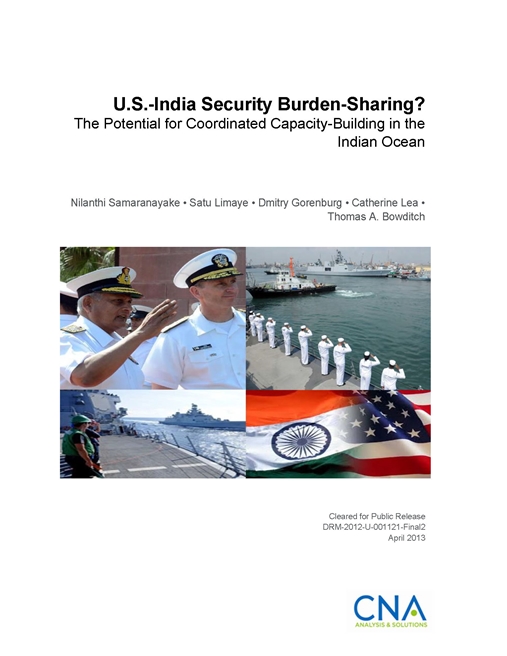The Indian Ocean (IO) is growing in strategic importance due to substantial trade and energy flows along the sea lines of communica- tion and through strait chokepoints. In an era of decreasing defense budgets, the United States will be more judicious in applying limited resources to build partnerships with countries in this vast region. A robust policy and academic discussion has emerged about the need for the United States to pursue a strategy of “offshore balancing,” following two costly land wars in Asia. By relying on “primarily naval and air engagements,” an offshore strategy suggests the United States pursue burden-sharing or “burden-shifting” with like-minded countries to lessen their free-riding off the American provision of the pub- lic good of security. Professor Christopher Layne describes an offshore balancing strategy as “getting other states to do more for their security so the United States can do less.”
India is a relatively new strategic partner of the United States due to its burgeoning economy, democratic political system, and the rise of China. Secretary of State Hillary Clinton has written that “the United States is making a strategic bet on India’s future—that India’s greater role on the world stage will enhance peace and security.” Secretary Clinton goes on to describe India’s central importance within the Obama administration’s “vision for a more economically integrated and politically stable South and Central Asia, with India as a linchpin.” In the January 2012 Department of Defense (DOD) Strategic Guidance, India featured prominently: “The United States is also investing in a long-term strategic partnership with India to support its ability to serve as a regional economic anchor and provider of security in the broader Indian Ocean region.” Given the United States’ new “pivot” or “rebalance” to Asia, India appears to be the logical partner for the United States in the IO.
Meanwhile, India’s central geographic position, long-standing socio- cultural ties to other IO countries, and soaring economy have further elevated the country’s standing in the region. India conducts security cooperation and assistance activities to further its regional relationships, as does the United States. In consideration of these parallel efforts, this study is motivated by a desire to see how the United States could pursue burden-sharing with India – especially given the climate of austerity in which the United States finds itself. A complementary, overarching goal is to find additional vehicles through which both countries can coordinate, especially in navy-to-navy ties, which are generally seen as having the greatest potential to advance overall bilateral relations. The November 2011 U.S. DOD Report to Congress on U.S.-India Security Cooperation explains that “the Department of Defense is continually looking for ways to expand defense cooperation with India.”
In this study, we draw conclusions about the art of the possible with regard to the potential for the United States to coordinate with India in the IO. In particular, we analyze possibilities regarding three South Asian littoral countries: Bangladesh, Sri Lanka, and Maldives. We also consider two countries outside South Asia—Seychelles and Mauritius—and in the outer IO to take a holistic approach to security coordination in the region.Finally, we investigate four potential areas of U.S.-India naval coordination: counterpiracy, counterterrorism (CT), maritime domain awareness (MDA), and humanitarian assistance/disaster relief (HA/DR). These areas were prioritized during the 2011 U.S.- India Defense Policy Group (DPG) meeting between U.S. Under Secretary of Defense for Policy Michèle Flournoy and Indian Defense Secretary Pradeep Kumar. According to the 2011 DOD report to Congress on U.S.-India security cooperation, they are considered to hold “great potential over the next five years” as areas for cooperation.
Download reportCleared for public release. Distribution unlimited.
Details
- Pages: 150
- Document Number: DRM-2012-U-001121-Final2
- Publication Date: 4/3/2013
